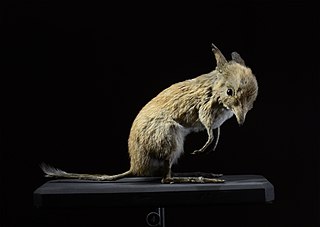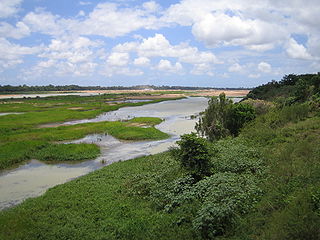
Diprotodon is an extinct genus of large marsupials native to Australia from the Pleistocene epoch. It is considered one of Australia's core species of "megafauna", which ranged throughout the continent during the Pleistocene. The genus is currently considered monotypic, containing only Diprotodon optatum, the largest known marsupial to have ever existed. The word diprotodon is constructed from the Ancient Greek words for 'two forward teeth'. Diprotodon existed from about 1.6 million years ago until extinction some 44,000 years ago.

Macrotis is a genus of desert-dwelling marsupial omnivores known as bilbies or rabbit-bandicoots; they are members of the order Peramelemorphia. At the time of European colonisation of Australia, there were two species. The lesser bilby became extinct in the 1950s; the greater bilby survives but remains endangered. It is currently listed as a vulnerable species. It is on average 55 cm (22 in) long, excluding the tail, which is usually around 29 cm (11 in) long. Its fur is usually grey or white, it has a long pointy nose and very long ears, hence earning its nick-name, the rabbit-eared bandicoot.

The greater bilby, often referred to simply as the bilby since the lesser bilby became extinct in the 1950s, is an Australian species of nocturnal omnivorous animal in the order Peramelemorphia. Other vernacular names include dalgyte, pinkie, or rabbit-eared bandicoot. Greater bilbies live in arid parts of northwestern and central Australia. Their range and population is in decline.

The order Peramelemorphia includes the bandicoots and bilbies; it equates approximately to the mainstream of marsupial omnivores. All members of the order are endemic to the twin land masses of Australia-New Guinea and most have the characteristic bandicoot shape: a plump, arch-backed body with a long, delicately tapering snout, very large upright ears, relatively long, thin legs, and a thin tail. Their size varies from about 140 grams up to 4 kilograms, but most species are about one kilogram, or the weight of a half-grown kitten.

Bandicoots are a group of more than 20 species of small to medium-sized, terrestrial, largely nocturnal marsupial omnivores in the order Peramelemorphia. They are endemic to the Australia–New Guinea region, including the Bismarck Archipelago to the east and Seram and Halmahera to the west.

Thylacoleo is an extinct genus of carnivorous marsupials that lived in Australia from the late Pliocene to the late Pleistocene. Some of these marsupial lions were the largest mammalian predators in Australia of their time, with Thylacoleo carnifex approaching the weight of a lioness. The estimated average weight for the species ranges from 101 to 130 kg.

Chaeropus, known as the pig-footed bandicoots, is a genus of small mammals that became extinct during the twentieth century. They were unique marsupials, of the order Peramelemorphia, with unusually thin legs yet were able to move rapidly. Two recognised species inhabited dense vegetation on the arid and semi-arid plains of Australia. The genus' distribution range was later reduced to an inland desert region, where it was last recorded in the 1950s; it is now presumed extinct.

Perameles is a genus of marsupials of the order Peramelemorphia. They are referred to as long-nosed bandicoots or barred bandicoots.

The marsupial family Peramelidae contains all of the extant bandicoots. They are found throughout Australia and New Guinea, with at least some species living in every available habitat, from rainforest to desert. Four fossil peramelids are described. One known extinct species of bandicoot, the pig-footed bandicoot, was so different from the other species, it was recently moved into its own family.

Quinkana is an extinct genus of crocodylians that lived in Australia from about 24 million to about 40,000 years ago. Most attributed specimens have been found in Queensland. It is speculated to have been one of the top predators of Pleistocene Australia.

Palorchestes is an extinct genus of terrestrial, herbivorous marsupials of the family Palorchestidae. The genus was endemic to Australia, living from the Miocene through to the Pleistocene epochs.

The Western barred bandicoot, also known as the Marl, is a small species of bandicoot; now extinct across most of its former range, the western barred bandicoot only survives on offshore islands and in fenced sanctuaries on the mainland.

The long-nosed bandicoot, a marsupial, is a species of bandicoot found in eastern Australia, from north Queensland along the east coast to Victoria. Around 40 centimetres (16 in) long, it is sandy- or grey-brown with a long snouty nose. Omnivorous, it forages for invertebrates, fungi and plants at night.

Elseya is a genus of large side-necked turtles, commonly known as Australian snapping turtles, in the family Chelidae. Species in the genus Elseya are found in river systems in northern and northeastern Australia and throughout the river systems of New Guinea. They are identified by the presence of alveolar ridges on the triturating surfaces of the mouth and the presence of a complex bridge strut.
Perameles allinghamensis, the Bluff Downs bandicoot, is a small extinct bandicoot that lived in Australia 4 million years ago in the Pliocene period. It was discovered at the Bluff Downs fossil site in northern Queensland. Its diet probably consisted of insects and soft roots dug for with its front claws.

The Bluff Downs fossil site is a paleontological site of Pliocene age in northern Queensland, Australia. It is one of the most significant fossil sites of Pliocene age in Australia due to its unique fauna and specific dating. The fossil site lies on the banks of the Allingham Creek on the pastoral property of Bluff Downs Station, northwest of Charters Towers on the Cape York Peninsula
Macropus pearsoni is an extinct Australian vertebrate species belonging to the family Macropodidae, and is in the same genus (Macropus) as extant kangaroos. M. pearsoni lived during the Pleistocene. It is known from fossil mandibles collected from Pleistocene beds from the Darling Downs in New South Wales, Lake Kanunka in northeastern South Australia, and the Cape York Peninsula.

Crash bandicoot is an extinct bandicoot, known from fossils located at the Riversleigh World Heritage Area in northeast Australia.

Gunggamarandu is an extinct genus of tomistomine crocodilian from Pliocene-Pleistocene aged deposits in the Darling Downs of Australia. Gunggamarandu represents the first tomistomine known from Oceania and it is also the southernmost known tomistomine to date. The type, and only known, species is G. maunala, which was described by Jorgo Ristevski et al. in 2021.

Bohra is an extinct genus of macropod from the Plio-Pleistocene of Australia.
















